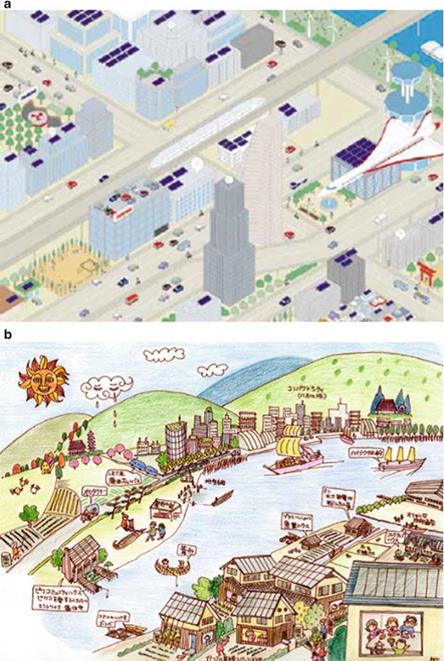The Japan Low-Carbon Society Project was launched in April 2004 under the sponsorship of the Global Environmental Research Fund (GERF) of the Ministry of the Environment. The project aimed to demonstrate the scientific evidence concerning the potential to reduce CO2 emissions by 70 % by 2050 while also meeting social and economic demands. The project team named the “Japan Low-Carbon Society Scenario Toward 2050 Team” consisted of about 60 researchers from the National Institute for Environmental Studies (NIES), Kyoto University, and Mizuho Information and Research Institute.
Using a “back-casting approach” in which the target was set first, and a quantitative investigation conducted to set measures required to meet this target, two narrative scenarios were set up: Scenario A (“active, quick-changing, and technology oriented”) and Scenario B (“calmer, slower, and nature oriented”) (NIES et al. 2008). Based on the two scenarios, the behavior of people, means of transportation, and industrial structure were quantified and calculated into energy – service demand. The appropriate combinations of end-use energy technologies and energy supply technologies were explored, and the amounts of CO2 emissions were calculated (NIES et al. 2008).
The two narrative scenarios are shown in Table 6.1 and their images are shown in Fig. 6.1.
In Scenario A, the innovations of technologies such as renewable energies, nuclear power, carbon capture and storage (CCS), and other low carbon energy technologies and changes in city structure toward a “pedestrian-friendly city” (NIES et al. 2008, p. 27), are shown to reduce the energy demand and carbon emissions by 70 %.
Alternatively, in Scenario B, people move from the city to seek a slow and self-sufficient lifestyle in rural areas. As a result, decentralization and deurbanization occur. Revitalized rural areas emerge with public and NGO participation.
|
Fig. 6.1 Images of Scenario A (a) and Scenario B (b). (From NIES et al. 2008, p. 31) |
More people will engage with the agriculture, fisheries, and forestry sectors and more people will have a preference for consuming rural products.
In Scenario B, small-size distributed energy systems, such as wind and biomass, are said to be more suitable, whereas “large-scale centralized energy systems such as nuclear power, carbon capture and storage (CCS), and hydrogen production” are necessary for Scenario A (NIES et al. 2008, p. 12).
Since the Great Tohoku Earthquake Disaster on 11 March 2011, debate on nuclear power has arisen as a result of the accident in the Fukushima Daiichi Nuclear Power Plant. In this context, it is likely that the weighting given to renewable energy will increase going forward.




